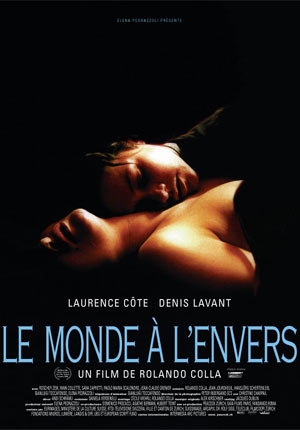Le monde à l'envers
| 1998 |
 |
1998, 100 min, 35mmby Rolando Colla with Laurence Côte, Denis Lavant, Sara Capretti, Roschdy Zem Original version in French |
https://peacock.ch/images/images/
| Director Statement |
Statement by Director Rolando Colla
Historical sources as a point of departure
The film "Le monde à l'envers" tells the (fictional) story of Anna Bruneau, who lived in the 18th century and wore men's clothes. I came across this subject matter through a number of books which, from various points of view, portrayed women who spent their lives dressed as men between the 16th and 19th centuries. It was Rudolf Dekker and Lotte van de Pol, with their sensitive description of 120 female transvestites from the Netherlands as well as other parts of Europe, who provided me with the most lasting inspiration (Rudolf Dekker/Lotte van de Pol, Frauen in Männerkleidern, Berlin 1990 (Women in Men's Clothes). What made the material so interesting to me was, at first, the clash of extremes: on the one hand the adventure, the fantasy, the transgression; on the other, the fear of being unmasked, the constant tension, the failure. The church condemned cross-dressing as blasphemy because it broke with the image of man and woman willed by God. For this reason it was punishable by death. Most of the accused, however, were banished or sent to the madhouse. Those found guilty of further serious crimes or those who were convicted of lesbian love were put to death. Our story takes place in the 18th century because the majority of cases of transvestite women come from this time. The little we know about these women comes from court records, the truth of which must be questioned if one takes into consideration that the hope of mitigation of a sentence or for an end to torture will often have led to false testimonies and forced confessions from the accused. A further source are the novels, plays and folk songs of the day, which either entertained or aimed to present a cautionary lesson. Hunting down the secret However, we know nothing about neither the real lives of these women, nor their feelings. As motivating factors for their travesty they cited poverty, patriotism, the desire to accompany a loved one, to escape unnoticed. Often, perhaps, deeper-seated psychological and sexual reasons may have played a decisive part. Another thing that interested me about this material, was the secret that these women took with them into exile or into death. I think they yearned for the boundless, the infinite. While working on the script we referred to a number of biographies which we came across. With a view to creating an exciting, emotional film, the extreme moments and situations interested us. Anna Bruneau is a brave woman with a mind of her own. But beneath the surface of Anna's determination which drives the film along, there beats a secret: that part of the truth we do not know and which perhaps even Anna herself does not know. Yes, Anna escapes us as authors, and this is a good thing, because it is what makes her fascinating. That Anna is fundamentally different, at once more withdrawn and more impulsive than most people, is part of her secret. Another part is that for her, love progresses along tortuous ways before becoming possible and that her sexual identity increasingly begins to confuse her. These were the thoughts which led us to seek out cinematographic processes and use dialogue sparingly. Combining live-action and animated footage We have provided Anna with her own, additional visual dimension which requires more detailed description. It is comparable to an inner monologue, except that it does not resort to words, existing only as images and sounds. At six points in the film the action takes off into an imaginary world, a world which has a special associative pictorial language: frame by frame, the live-action footage is painted on and altered, juxtaposed with old engravings and other images. The animator Gianluigi Toccafondo and his team have created these sequences. They are interwoven into the action, taken from it and, in turn, influence it. They are a complement to Anna's isolation because they provide insight into Anna's inner world. We also chose to use a further technique in order to lend a stronger dream-like quality to some scenes: The images were re-coloured, provided with a blurred edge, and in some cases further distorted by means of shutter effects. Universal appeal These painted, freely inspired passages give the film something contemporary and make Anna's story more universal. "Le monde à l'envers" is a film about the kind of happiness which can only (if at all) be found by stepping out of line, by being independent, by taking the risky path chosen by oneself. In this respect the story speaks of something timelessly human: the belief in a better life, in happiness, in a utopia. |
|

